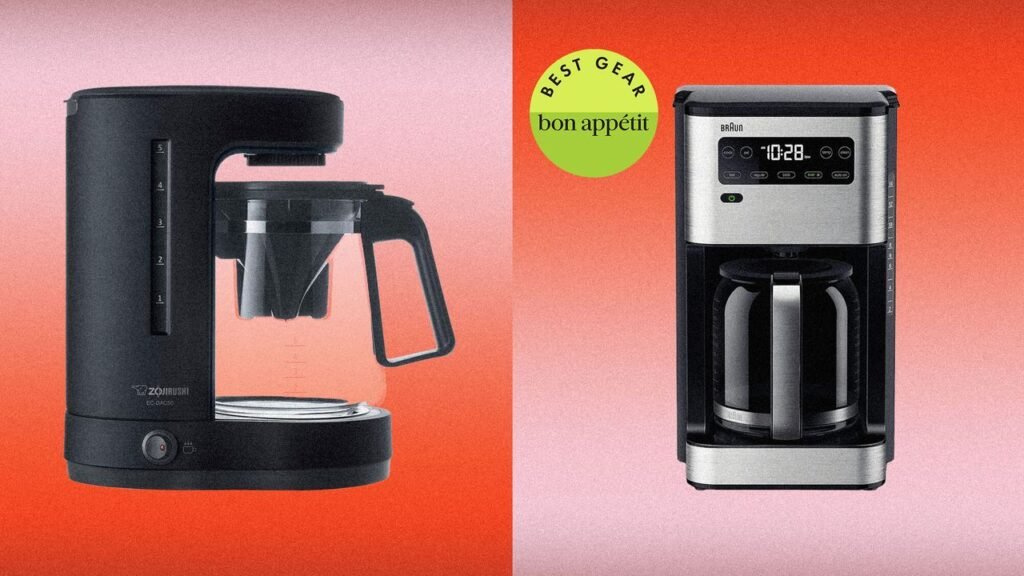I also looked at the water distribution mechanism that Bilosi mentioned, preferring ones that used a wider showerhead configuration that could get water all the way across the coffee bed.
I took the temperature of the water as it came out of the brewer, because another well-known shortcoming of cheap coffee makers is that they don’t get the water hot enough to properly extract flavor. The best machines in this test had water come out in the low 180°Fs, disappointing machines had water in the low 170°Fs (I wasn’t equipped to take the temperature of the water as it came out of the showerhead, or I would have taken it there).
Finally, I looked at the coffee bed after brewing. Bilosi says one surefire indicator of uneven extraction is deep channeling in the coffee bed that looks like someone burrowed a few narrow holes all the way down. I looked for coffee that was wet all the way across, as well as fairly flat.
Other cheap coffee makers I tested and liked
Calphalon 14-Cup Programmable Coffee Maker
The Calphalon ran an admirable second to the Braun in terms of flavor and I don’t think anyone in the market for this kind of coffee maker would be unhappy with this one. The interface is a little easier to use on the Braun and it also come with the extra over-ice feature. Depending on what’s on sale in any given week though, the Calphalon may be a little bit cheaper, which could tip the scales in its favor.
Mr. Coffee 14-Cup Programmable Coffee Maker
In parts of the coffee commentariat, Mr. Coffee is a bit of a punching bag, shorthand for mediocre drip coffee. But I’ve used several of Mr. Coffee’s machines (this is the least expensive one), and they have improved. The coffee from this XL option didn’t hit all the flavor notes that some other machines I used did, but it was smooth, if a little bit watery. The water temperature as it came off the brewer was notably lower than the Braun, which could account for some of that drop off in flavor. But it’s certainly a big step up from a couple of coffee makers on this list.
Kenmore Drip Coffee Maker
The Kenmore machine really did draw out good flavor notes in the coffee and had water come out in a few pulses. The water wasn’t quite as hot as the Braun, and the coffee was just a hair duller in taste.
Cheap coffee makers we don’t recommend
The Ninja has a lot of the bells and whistles of the best cheap coffee makers—two different brew settings, a delay timer, a removable water tank—but it just didn’t make coffee that tasted as good. The flavor was flat, even when set on the ostensibly more robust “bold” setting.
This is a good example of why pinching every penny will eventually come back to bite you if what you’re after is more than C- coffee. At $24 (at the time of writing) this is the cheapest of the cheap coffee makers I’ve tried and it shows. The coffee tasted like hot water and when I looked at the brew basket, the coffee had deep channels running through it.
You can’t drink pots of coffee from this many cheap machines and not end up with something really bad eventually. And that’s what I got from this Black & Decker. The sludgy coffee tasted like mud, and even the addition of a thermal carafe (the only coffee maker in this story that had one) could not save it.
Can I do anything to make better coffee in my cheap coffee maker?
You sure can. “If possible, weigh both your coffee and your water to control the ratio,” says Bilosi. “A good starting point is a 1:16 coffee to water ratio [in grams], which you can adjust to taste from there.” To put that in concrete terms, for one of these 12-cup coffee makers (which uses 1700 grams of water), you’d want to use 106 grams of coffee. A scale is obviously the best way to measure that, but if you must use a volume measure, you can ballpark it at one cup of coffee.
Besides the amount of coffee, the other thing you have control over, if you go the cheap coffee maker route, is the grind of your coffee. The mistake I’ve seen most often is people grinding too coarsely. Generally, you want to use a medium grind for drip coffee, but if you aren’t getting the flavor you want, try a slightly finer grind and see if that improves things.
All that said, you could also abandon the drip coffee maker altogether. “I’m very pro pour-over,” adds Bilosi. “Pour over setups are also relatively affordable, especially compared to higher quality drip coffee makers that are made to mimic the manual pouring of a pour over. The affordability will let you invest in other equipment like a grinder, scale, and kettle over time, which can continue to help with precision and consistency in brewing.”




